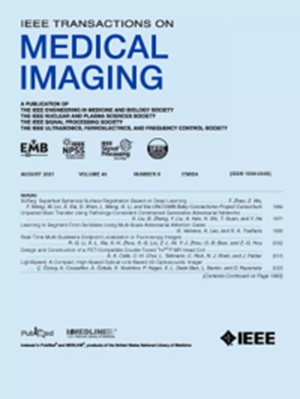超声心动图主动脉狭窄分类的多模态标签噪声鲁棒框架。
IF 9.8
1区 医学
Q1 COMPUTER SCIENCE, INTERDISCIPLINARY APPLICATIONS
引用次数: 0
摘要
主动脉瓣狭窄(AS)是一种普遍而严重的心脏瓣膜疾病,需要早期发现,但在常规实践中仍然难以诊断。虽然超声心动图与多普勒成像是临床标准,这些评估通常仅限于训练有素的专家。即时超声(POCUS)为AS筛查提供了一种可行的替代方法,但仅限于基本的2D b模式成像,通常缺乏多普勒提供的分析。我们的项目引入了MultiASNet,这是一个多模式机器学习框架,旨在通过将2D b模式视频与超声心动图报告的结构化数据(包括多普勒参数)相结合,增强对POCUS的AS筛查。使用对比学习,MultiASNet将来自同一患者的视频特征与报告特征以表格形式对齐,以提高解释质量。为了解决单个报告对应多个视频视图的不一致问题,其中一些与AS诊断无关,我们在基于变压器的视频和表格网络中使用交叉注意来分配不相关报告数据的重要性。该模型仅在训练期间集成结构化数据,可以在推理期间与b模式视频独立使用,以获得更广泛的可访问性。MultiASNet还结合了样本选择来抵消观察者可变性带来的标签噪声,从而提高了两个数据集的准确性。对于AS检测,我们在私有数据集上实现了93.0%的平衡准确率,在公共TMED-2数据集上实现了83.9%的平衡准确率。对于严重性分类,在私有和公共数据集上的平衡准确率得分分别为80.4%和59.4%。该模型有助于在非专业环境中进行可靠的AS筛查,弥补了多普勒数据留下的空白,同时减少了与噪声相关的错误。我们的代码可以在github.com/DeepRCL/MultiASNet上公开获得。本文章由计算机程序翻译,如有差异,请以英文原文为准。
MultiASNet: Multimodal Label Noise Robust Framework for the Classification of Aortic Stenosis in Echocardiography.
Aortic stenosis (AS), a prevalent and serious heart valve disorder, requires early detection but remains difficult to diagnose in routine practice. Although echocardiography with Doppler imaging is the clinical standard, these assessments are typically limited to trained specialists. Point-of-care ultrasound (POCUS) offers an accessible alternative for AS screening but is restricted to basic 2D B-mode imaging, often lacking the analysis Doppler provides. Our project introduces MultiASNet, a multimodal machine learning framework designed to enhance AS screening with POCUS by combining 2D B-mode videos with structured data from echocardiography reports, including Doppler parameters. Using contrastive learning, MultiASNet aligns video features with report features in tabular form from the same patient to improve interpretive quality. To address misalignment where a single report corresponds to multiple video views, some irrelevant to AS diagnosis, we use cross-attention in a transformer-based video and tabular network to assign less importance to irrelevant report data. The model integrates structured data only during training, enabling independent use with B-mode videos during inference for broader accessibility. MultiASNet also incorporates sample selection to counteract label noise from observer variability, yielding improved accuracy on two datasets. We achieved balanced accuracy scores of 93.0% on a private dataset and 83.9% on the public TMED-2 dataset for AS detection. For severity classification, balanced accuracy scores were 80.4% and 59.4% on the private and public datasets, respectively. This model facilitates reliable AS screening in non-specialist settings, bridging the gap left by Doppler data while reducing noise-related errors. Our code is publicly available at github.com/DeepRCL/MultiASNet.
求助全文
通过发布文献求助,成功后即可免费获取论文全文。
去求助
来源期刊

IEEE Transactions on Medical Imaging
医学-成像科学与照相技术
CiteScore
21.80
自引率
5.70%
发文量
637
审稿时长
5.6 months
期刊介绍:
The IEEE Transactions on Medical Imaging (T-MI) is a journal that welcomes the submission of manuscripts focusing on various aspects of medical imaging. The journal encourages the exploration of body structure, morphology, and function through different imaging techniques, including ultrasound, X-rays, magnetic resonance, radionuclides, microwaves, and optical methods. It also promotes contributions related to cell and molecular imaging, as well as all forms of microscopy.
T-MI publishes original research papers that cover a wide range of topics, including but not limited to novel acquisition techniques, medical image processing and analysis, visualization and performance, pattern recognition, machine learning, and other related methods. The journal particularly encourages highly technical studies that offer new perspectives. By emphasizing the unification of medicine, biology, and imaging, T-MI seeks to bridge the gap between instrumentation, hardware, software, mathematics, physics, biology, and medicine by introducing new analysis methods.
While the journal welcomes strong application papers that describe novel methods, it directs papers that focus solely on important applications using medically adopted or well-established methods without significant innovation in methodology to other journals. T-MI is indexed in Pubmed® and Medline®, which are products of the United States National Library of Medicine.
 求助内容:
求助内容: 应助结果提醒方式:
应助结果提醒方式:


